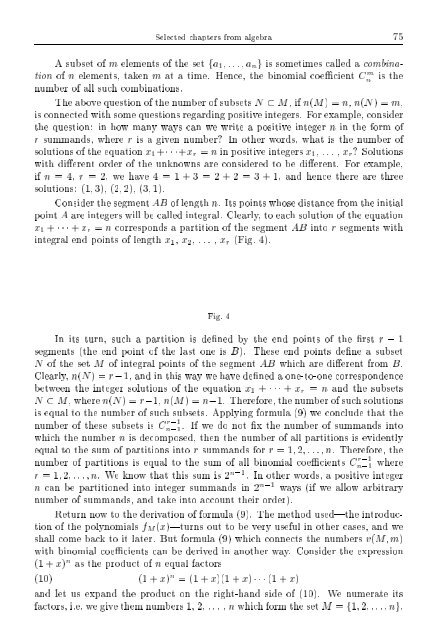SELECTED CHAPTERS FROM ALGEBRA I. R. Shafarevich Preface
SELECTED CHAPTERS FROM ALGEBRA I. R. Shafarevich Preface
SELECTED CHAPTERS FROM ALGEBRA I. R. Shafarevich Preface
Create successful ePaper yourself
Turn your PDF publications into a flip-book with our unique Google optimized e-Paper software.
Selected chapters from algebra 75A subset of m elements of the set fa 1 ...a n g is sometimes called a combinationof n elements, taken m at a time. Hence, the binomial coecient Cnm is thenumber of all such combinations.The above question of the number of subsets N M, ifn(M) =n, n(N) =m,is connected with some questions regarding positive integers. For example, considerthe question: in how manyways can we write a positive integer n in the form ofr summands, where r is a given number? In other words, what is the number ofsolutions of the equation x 1 ++x r = n in positive integers x 1 ,... ,x r ? Solutionswith dierent order of the unknowns are considered to be dierent. For example,if n = 4, r = 2, we have 4= 1+3 = 2+2 = 3+1, and hence there are threesolutions: (1 3), (2 2), (3 1).Consider the segment AB of length n. Its points whose distance from the initialpoint A are integers will be called integral. Clearly, to each solution of the equationx 1 + + x r = n corresponds a partition of the segment AB into r segments withintegral end points of length x 1 , x 2 ,...,x r (Fig. 4).Fig. 4In its turn, such a partition is dened by the end points of the rst r ; 1segments (the end point of the last one is B). These end points dene a subsetN of the set M of integral points of the segment AB which are dierent from B.Clearly, n(N) =r ;1, and in this way wehave dened a one-to-one correspondencebetween the integer solutions of the equation x 1 + + x r = n and the subsetsN M, where n(N) =r;1, n(M) =n;1. Therefore, the number of such solutionsis equal to the number of such subsets. Applying formula (9) we conclude that thenumber of these subsets is C r;1n;1. If we do not x the number of summands intowhich thenumber n is decomposed, then the number of all partitions is evidentlyequal to the sum of partitions into r summands for r =1 2 ...n. Therefore, thenumber of partitions is equal to the sum of all binomial coecients C r;1n;1 wherer =1 2 ...n. We know that this sum is 2 n;1 . In other words, a positive integern can be partitioned into integer summands in 2 n;1 ways (if we allow arbitrarynumber of summands, and take into account their order).Return now to the derivation of formula (9). The method used|the introductionof the polynomials f M (x)|turns out to be very useful in other cases, and weshall come back toitlater.But formula (9) which connects the numbers v(Mm)with binomial coecients can be derived in another way. Consider the expression(1 + x) n as the product of n equal factors(10) (1 + x) n =(1+x)(1 + x) (1 + x)and let us expand the product on the right-hand side of (10). We numerate itsfactors, i.e. we give them numbers 1, 2, . . . , n which formthesetM = f1 2 ...ng.
















